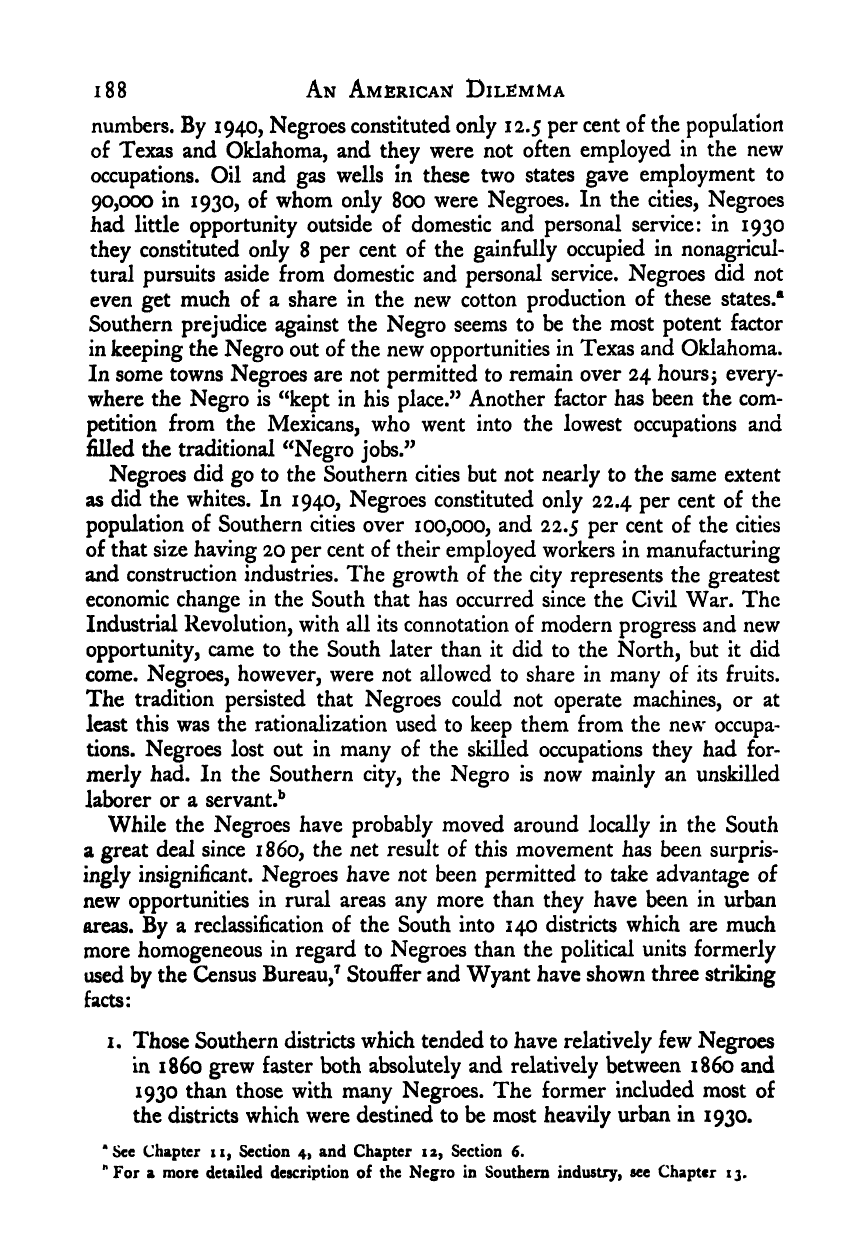Note: Gunnar Myrdal died in 1987, less than 70 years ago. Therefore, this work is protected by copyright, restricting your legal rights to reproduce it. However, you are welcome to view it on screen, as you do now. Read more about copyright.
Full resolution (TIFF) - On this page / på denna sida - III. Population and Migration - 8. Migration - 2. A Closer View

<< prev. page << föreg. sida << >> nästa sida >> next page >>
Below is the raw OCR text
from the above scanned image.
Do you see an error? Proofread the page now!
Här nedan syns maskintolkade texten från faksimilbilden ovan.
Ser du något fel? Korrekturläs sidan nu!
This page has never been proofread. / Denna sida har aldrig korrekturlästs.
1 88 An American Dilemma
numbers. By 1940, Negroes constituted only 12.5 per cent of the population
of Texas and Oklahoma, and they were not often employed in the new
occupations. Oil and gas wells in these two states gave employment to
90,cxx> in 1930, of whom only 800 were Negroes. In the cities, Negroes
had little opportunity outside of domestic and personal service: in 1930
they constituted only 8 per cent of the gainfully occupied in nonagricul-
tural pursuits aside from domestic and personal service. Negroes did not
even get much of a share in the new cotton production of these states.*
Southern prejudice against the Negro seems to be the most potent factor
in keeping the Negro out of the new opportunities in Texas and Oklahoma.
In some towns Negroes are not permitted to remain over 24 hours} every-
where the Negro is “kept in his place.” Another factor has been the com-
petition from the Mexicans, who went into the lowest occupations and
filled the traditional “Negro jobs.”
Negroes did go to the Southern cities but not nearly to the same extent
as did the whites. In 1940, Negroes constituted only 22.4 per cent of the
population of Southern cities over 100,000, and 22.5 per cent of the cities
of that size having 20 per cent of their employed workers in manufacturing
and construction industries. The growth of the city represents the greatest
economic change in the South that has occurred since the Civil War. The
Industrial Revolution, with all its connotation of modern progress and new
opportunity, came to the South later than it did to the North, but it did
come. Negroes, however, were not allowed to share in many of its fruits.
The tradition persisted that Negroes could not operate machines, or at
least this was the rationalization used to keep them from the new occupa-
tions. Negroes lost out in many of the skilled occupations they had for-
merly had. In the Southern city, the Negro is now mainly an unskilled
laborer or a servant.**
While the Negroes have probably moved around locally in the South
a great deal since i860, the net result of this movement has been surpris-
ingly insignificant. Negroes have not been permitted to take advantage of
new opportunities in rural areas any more than they have been in urban
areas. By a reclassification of the South into 140 districts which are much
more homogeneous in regard to Negroes than the political units formerly
used by the Census Bureau,^ Stouifer and Wyant have shown three striking
facts:
I. Those Southern districts which tended to have relatively few Negroes
in i860 grew faster both absolutely and relatively between i860 and
1930 than those with many Negroes. The former included most of
the districts which were destined to be most heavily urban in 1930.
’’See Chapter xi, Section 4, and Chapter 12, Section 6.
*’ For a more detailed description of the Negro in Southern industry, see Chapter 13.
<< prev. page << föreg. sida << >> nästa sida >> next page >>